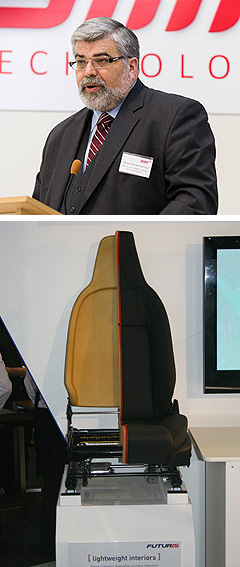AutoCRC wins $26m funding boost
BY IAN PORTER | 24th Nov 2011

One of only six research organisations from 26 applicants to be allocated funding, AutoCRC’s grant – from a total pool of $148 million – should secure its operations until mid-2019, with the current seven-year cycle ending in June next year.
The funding will enable AutoCRC – and the federal government – to continue its push to strengthen Australian car manufacturing and the supply chain under the Automotive Australia 2020 roadmap released last year, which has vehicle electrification, including hybrid and electric vehicles, as its core tenet.
As GoAuto has reported, the other “long-term opportunities” identified in the roadmap cover gaseous fuels, light weight technology, and data and communications.
This was the 14th round of funding since the CRC program started in 1991, although the AutoCRC was only created in 2005 “as part of a national strategy to secure Australia's position in the global automotive industry”.
An independent selection panel assessed the applications with no input from federal innovation, industry, science and research minister, Kim Carr, who in an interview with GoAuto this week said work could now continue on forging closer ties for the Australian car industry – particularly suppliers – in Asia.

“There was very stiff competition,” Senator Carr said. “The AutoCRC did very well in the ratings.
“They got up because of the quality of their work.”Senator Carr said Australia was well placed to engage with the rapidly growing Asian automotive industry by providing technology for low-emission cars and sustainable manufacturing.
He said the AutoCRC, which is now technically called Automotive Australia 2020 (by virtue of its management of the roadmap) rather than the Co-operative Research Centre for Advanced Automotive Technology, would tackle the complex issues that are impeding the uptake of low-carbon vehicles worldwide.
As previously reported, the AutoCRC has helped create some significant new products like a new, all-plastic rearview mirror for SMR Automotive, an Indian-owned company based in Adelaide. SMR was previously known as Schefenaker and before that Britax Rainsfords.
An AutoCRC research team including SMR, the University of South Australia and other participants invented a plastic coating technology that allows the traditional glass reflector and backing plate in a mirror to be replaced with a plastic part, saving around half a kilogram per vehicle.
Another team worked with Futuris Interiors, CSIRO and Deakin University to develop a seat that has no metal frame. The metal is replaced by an aramid fibre – a synthetic that is heat-resistant and strong – that is knitted into the shape of a seat frame using a standard industrial knitting machine.
These knitted forms can be packed flat, which means they can be shipped around the world, whereas traditional seats cannot. At the assembly line, the knitted form is placed in a mould and inflated into shape, a process that simultaneously hardens the impregnated setting agent.
The AutoCRC has also developed a business improvement program, the Automotive Supplier Excellence Australia program, for smaller parts-makers in Australia that need assistance in raising their performance.
By using international benchmarks, local companies can lift their performance in all areas of operations, whether this is management, manufacturing or any other aspect of the business. This program is claimed to have already saved some parts-makers millions of dollars.
There are also other programs which help better understand the design process, such as an ergonomics lab which studies the human form as it enters and exits a motor vehicleThe AutoCRC also played a key role in the establishment of an electricity generation company – gT-Energy Technologies – that has developed a portable generator powered by the waste heat from industrial processes.
At the core of any CRC program is to bring industry, scientific and research institutions together to develop new products and processes that can give Australian companies a competitive edge.
When he announced the six successful CRC applicants, Senator Carr highlighted the prospect of the AutoCRC working more closely with Asian partners in future.
In the last year or two, the AutoCRC has signed research co-operation agreements with the fast-growing Chery Automobile Company in Anhui province in China and with the Kookmin University in Korea.
“The AutoCRC’s work is aimed at the automotive industry supply chain. That’s why we are pushing into Asia,” said Senator Carr.
He said many Chinese car-makers wanted access to technology from new sources so their vehicles could be different from those using parts and technologies from the major US and European parts suppliers.
“We’ve expanded quite significantly in China. Recently I was in India. We’ve been to Malaysia we are trying to open up opportunities in Indonesia.
“These are through Austrade, but we are also putting special efforts in there. Our automotive industry ambassadors (former Victorian premier) Steve Bracks and (former Toyota Australia chairman) John Conomos are also working hard.”But Senator Carr stressed that he wanted more Australian parts-makers to work with the AutoCRC.
“Obviously we have indicated to them we want them to be more adaptable. We want them to attract further investment in the industry and the way to do that is to deploy new technology.”There are more than 40 CRCs operating across Australia, working in areas including agriculture, forestry and fishing, mining, manufacturing and services.
The CRC Program was designed to link researchers with industry to focus R&D efforts on developing new products and techniques and commercialising them.
So far a total of 190 CRCs have been funded by the federal government, with 44 currently in existence in the broad areas of agriculture, forestry and fishing, mining, manufacturing and services.
Since the inception of the CRC program, the federal government has committed more than $3.4 billion in CRC funding and CRC participants have committed a further $10.9 billion in cash and in-kind contributions.